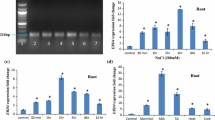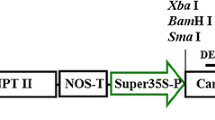Abstract
Stress-induced accumulation of five (COR47, LTI29, ERD14, LTI30 and RAB18) and tissue localization of four (LTI29, ERD14, LTI30 and RAB18) dehydrins in Arabidopsis were characterized immunologically with protein-specific antibodies. The five dehydrins exhibited clear differences in their accumulation patterns in response to low temperature, ABA and salinity. ERD14 accumulated in unstressed plants, although the protein level was up-regulated by ABA, salinity and low temperature. LTI29 mainly accumulated in response to low temperature, but was also found in ABA- and salt-treated plants. LTI30 and COR47 accumulated primarily in response to low temperature, whereas RAB18 was only found in ABA-treated plants and was the only dehydrin in this study that accumulated in dry seeds.
Immunohistochemical localization of LTI29, ERD14 and RAB18 demonstrated tissue and cell type specificity in unstressed plants. ERD14 was present in the vascular tissue and bordering parenchymal cells, LTI29 and ERD14 accumulated in the root tip, and RAB18 was localized to stomatal guard cells. LTI30 was not detected in unstressed plants. The localization of LTI29, ERD14 and RAB18 in stress-treated plants was not restricted to certain tissues or cell types. Instead these proteins accumulated in most cells, although cells within and surrounding the vascular tissue showed more intense staining. LTI30 accumulated primarily in vascular tissue and anthers of cold-treated plants.
This study supports a physiological function for dehydrins in certain plant cells during optimal growth conditions and in most cell types during ABA or cold treatment. The differences in stress specificity and spatial distribution of dehydrins in Arabidopsis suggest a functional specialization for the members of this protein family.
Similar content being viewed by others
References
Arora, R. and Wisniewski, M.E. 1994. Cold acclimation in genetically related (sibling) deciduous and evergreen peach (Prunus persica [L.] Batsch), II. A 60-kilodalton bark protein in cold-acclimated tissues of peach is heat stable and related to the dehydrin family of proteins. Plant Physiol. 105: 95-101.
Artlip, T.S., Callahan, A.M., Bassett, C.L. and Wisniewski, M.E. 1997. Seasonal expression of a dehydrin gene in sibling deciduous and evergreen genotypes of peach (Prunus persica [L.] Batsch). Plant Mol. Biol. 33: 61-70.
Bravo, L.A., Close, T.J., Corcuera, L.J. and Guy, C.L. 1999. Characterization of an 80-kDa dehydrin-like protein in barley responsive to cold acclimation. Physiol. Plant. 106: 177-183.
Bray, E.A. 1997. Plant responses to water deficit. Trends Plant Sci 2: 48-54.
Choi, D.W., Zhu, B. and Close, T.J. 1999. The barley (Hordeum vulgare L.) dehydrin multigene family: sequences, allele types, chromosome assignments, and expression characteristics of 11 Dhn genes of cv. Dicktoo. Theor. Appl. Genet. 98: 1234-1247.
Close, T.J. 1997. Dehydrins: a commonality in the response of plants to dehydration and low temperature. Physiol. Plant. 100: 291-296.
Close, T.J. 1996. Dehydrins: emergence of a biochemical role of a family of plant dehydration proteins. Physiol. Plant. 97: 795-803.
Danyluk, J., Perron, A., Houde, M., Limin, A., Fowler, B., Benhamou, N. and Sarhan, F. 1998. Accumulation of an acidic dehydrin in the vicinity of the plasma membrane during cold acclimation of wheat. Plant Cell 10: 623-638.
del Mar Parra, M., del Pozo, O., Luna, R., Godoy, J.A. and Pintor-Toro, J.A. 1996. Structure of the dehydrin tas14 gene of tomato and its developmental and environmental regulation in transgenic tobacco. Plant Mol. Biol. 32: 453-460.
Dure, L. 1993. Structural motifs in Lea proteins. In: T.J. Close and E.A. Bray (Eds.) Plant Responses to Cellular Dehydration during Environmental Stress, American Society of Plant Physiologists, Rockeville, MN, pp. 91-103.
Gilmour, S.J., Artus, N.N. and Thomashow, M.F. 1992. cDNA sequence analysis and expression of two cold-regulated genes of Arabidopsis thaliana. Plant Mol. Biol. 18: 13-21.
Giraudat, J., Hauge, B.M., Valon, C., Smalle, J., Parcy, F. and Goodman H.M. 1992. Isolation of the Arabidopsis ABI3 gene by positional cloning. Plant Cell 4: 1251-1261.
Goday, A., Jensen, A.B., Culiáñez-Maciá, F.A., Albá, M.M., Figueras, M., Serratosa, J., Torrent, M. and Pagès, M. 1994. The maize abscisic acid-responsive protein Rab17 is localized in the nucleus and cytoplasm and interacts with nuclear localization signals. Plant Cell 6: 351-360.
Godoy, J.A., Lunar, R., Torres-Shumann, S., Moreno, J., Rodrigo, R.M. and Pintor-Toro, J.A. 1994. Expression, tissue distribution and subcellular localization of dehydrin TAS14 in salt-stressed tomato plants. Plant Mol. Biol. 26: 1921-1934.
Gosti, F., Bertauche, N., Vartanian, N. and Giraudat, J. 1995. Abscisic acid-dependent and-independent regulation of gene expression by progressive drought in Arabidopsis thaliana.Mol. Gen. Genet. 246: 10-18.
Guy, C.L. 1990. Molecular mechanisms of cold acclimation. In: F. Katterman (Ed.) Environmental Injury to Plants, Academic Press, London, pp. 35-61.
Houde, M., Daniel, C., Lachapelle, M., Allard, F., Laliberté, S. and Sarhan, F. 1995. Immunolocalization of freezing-tolerance-associated proteins in the cytoplasm and nucleoplasm of wheat crown tissues. Plant J. 8: 583-593.
Hughes, M.A. and Dunn, M.A. 1996. The molecular biology of plant cold acclimation to low temperature. J. Exp. Bot. 47: 291-305.
Ismail, A.M., Hall, A.E. and Close, T.J. 1999. Purification and partial characterization of a dehydrin involved in chilling tolerance during seedling emergence of cowpea. Plant Physiol. 120: 237-244.
Jarvis, S.B., Taylor, M.A., MacLeod M.R. and Davies, H.V. 1996. Cloning and characterisation of the cDNA clones of three genes that are differentially expressed during dormancy-breakage in the seeds of Douglas fir (Pseudotsuga menziesii). J. Plant Physiol. 147: 559-566.
Jensen, A.B., Goday, A., Figueras, M., Jessop, A.C. and Pagès, M. 1998. Phosphorylation mediates the nuclear targeting of the maize Rab17 protein. Plant J. 13: 691-697.
Kiyosue, T., Yamaguchi-Shinozaki, K. and Shinozaki, K. 1994. Characterization of two cDNAs (ERD10 and ERD14) corresponding to genes that respond rapidly to dehydration stress in Arabidopsis thaliana. Plant Cell Physiol. 35: 225-231.
Koornneef, M., Jorna, M.L., Brinkhorst-van der Swan, D.L.C. and Karssen, C.M. 1982. The isolation of abscisic acid (ABA) deficient mutants by selection of induced revertants in non-germinating gibberellin sensitive lines of Arabidopsis thaliana (L.) Heynh. Theor. Appl. Genet. 61: 385-393.
Koornneef, M., Reuling, G. and Karssen, C.M. 1984. The isolation and characterization of abscisic acid-insensitive mutants of Arabidopsis thaliana. Physiol. Plant. 61: 377-383.
Li, R., Brawley, S. H. and Close T.J. 1998. Proteins immunologically related to dehydrins in fucoid algae. J. Phycol. 34: 642-650.
Lång, V. and Palva, E.T. 1992. The expression of a rab-related gene, rab18, is induced by abscisic acid during the cold acclimation process of Arabidopsis thaliana (L.) Heynh. Plant Mol. Biol. 20: 951-962.
Lång, V., Heino, P. and Palva, E.T. 1989. Low temperature acclimation and treatment with exogenous abscisic acid induce common polypeptides in Arabidopsis thaliana (L.) Heynh. Theor. Appl. Genet. 77: 729-734.
Mäntylä, E., Lång, V. and Palva, E.T. 1995. Role of abscisic acid in drought-induced freezing tolerance, cold acclimation, and accumulation of LTI78 and RAB18 proteins in Arabidopsis thaliana. Plant Physiol. 107: 141-148.
Mundy, J. and Chua, N.H. 1988. Abscisic acid and water-stress induced the expression of a novel rice gene. EMBO J. 7: 2279-2286.
Palta, J. and Weiss, L.S. 1993. Ice formation and freezing injury: an overview on the survival mechanisms and molecular aspects of injury and cold acclimation in herbaceous plants. In: P.H. Li and L. Christersson (Eds.) Advances in Plant Cold Hardiness, CRC Press, Boca Raton, FL, pp. 143-176.
Palva, E.T. 1994. Gene expression under low temperature stress. In: A.S. Basra (Ed.) Stress-Induced Gene Expression in Plants, Harwood Academic Publishers, New York, pp. 103-130.
Parcy, F., Valon, C., Raynal, M., Gaubier-Comella, P., Delseny, M. and Giradaut, J. 1994. Regulation of gene expression program during Arabidopsis seed development: roles of the ABI3 locus and of endogenous abscisic acid.Plant Cell 6: 1567-1582.
Richard, S., Morency, M-J., Drevet, C., Jouanin, L. and Séguin A. 2000. Isolation and characterization of a dehydrin gene from white spruce induced upon wounding, drought and cold stresses. Plant Mol. Biol. 43: 1-10.
Rinne, P.L.H., Kaikuranta, P.L.M., van der Plas, L.H.W. and van der Schoot, C. 1999. Dehydrins in cold-acclimated apices of birch (Betula pubescens Ehrh.): production, localization and potential role in rescuing enzyme function during dehydration. Planta 209: 377-388.
Robertson, M. and Chandler, P.M. 1994. A dehydrin cognate protein from pea (Pisum sativum L.) with an atypical pattern of expression. Plant Mol. Biol. 26: 805-816.
Rouse, D., Gehring, C.A. and Parish, R.W. 1992. Structure and sequence of a dehydrin-like gene in Arabidopsis thaliana.Plant Mol. Biol. 19: 531-532.
Rouse, D.T., Marotta, R. and Parish, R.W. 1996. Promoter and expression studies on an Arabidopsis thaliana dehydrin gene. FEBS Lett. 381: 252-256.
Shen, L., Outlaw, W.H., Jr and Epstein, L.M. 1995. Expression of an mRNA with sequence similarity to pea dehydrin (Psdhn1)in guard cells of Vicia faba in response to exogenous abscisic acid. Physiol. Plant. 95: 99-105.
Svensson, J., Palva E.T. and Welin B. 2000. Purification of recombinant Arabidopsis thaliana dehydrins by metal ion affinity chromatography. Protein Expr. Purif., in press.
Swire-Clark, G.A. and Marcotte, W.R. 1999. The wheat LEA protein Em functions as an osmoprotective molecule in Saccha-romyces cerevisiae. Plant Mol. Biol. 39: 117-128.
Taylor, J.E., Renwick, K.F., Webb, A.A., McAinsh, M.R., Furini, A., Bartels, D., Quatrano, R.S., Marcotte, W.R. Jr. and Hetherington, A.M. 1995. ABA-regulated promoter activity in stomatal guard cells. Plant J. 7: 129-134.
Thomashow, M.F. 1998. Role of cold-responsive genes in plant freezing tolerance. Plant Physiol. 118: 1-7.
Verwoerd, T.C., Dekker, B.M.M. and Hoekema, A. 1989. A small scale procedure for the rapid isolation of plant RNAs. Nucl. Acids Res. 17: 2362.
Vilardell, J., Goday, A., Freire, M.A., Torrent, M., Martinez, M.C., Torne, J.M. and Pagès, M. 1990. Gene sequence, developmental expression, and protein phosphorylation of RAB17 in maize. Plant Mol. Biol. 14: 423-432.
Vilardell, J., Martínez-Zapater, J.M., Godoy, A., Arenas, C. and Pagès, M. 1994. Regulation of the rab17 gene promotor in transgenic Arabidopsis wild-type, ABA-deficient and ABA-insensitive mutants. Plant Mol. Biol. 24: 561-569.
Wang, H. and Cutler, A.J. 1995. Promoters from kin1 and cor6.6, two Arabidopsis thaliana low-temperature-and ABA-inducible genes, direct strong β-glucuronidase expression in guard cells, pollen and young developing seeds. Plant Mol. Biol. 28: 619-634.
Welin, B.V., Olson, Å., Nylander, M. and Palva, E.T. 1994. Characterization and differential expression of dhn/lea/rab-like genes during cold acclimation and drought stress in Arabidopsis thaliana. Plant Mol. Biol. 26: 131-144.
Yamaguchi-Shinozaki, K., Mundy, J. and Chua, N-H. 1989. Four tightly linked rab genes are differentially expressed in rice. Plant Mol. Biol. 14: 29-39.
Yamaguchi-Shinozaki, K. and Shinozaki, K. 1993. The plant hormone abscisic acid mediates the drought-induced expression but not the seed-specific expression of rd22, a gene responsive to dehydration stress in Arabidopsis thaliana. Mol. Gen. Genet. 238: 17-25.
Zhang, L., Ohta, A., Takagi, M. and Imai, R. 2000. Expression of plant group 2 and group 3 lea genes in Saccharomyces cerevisiae revealed functional divergence among LEA proteins. J. Biochem. 127: 611-616.
Zhu, J.K., Hasegawa, P.M. and Bressan, R.A. 1997. Molecular aspects of osmotic stress in plants. Crit. Rev. Plant Sci. 16: 253-277.
Author information
Authors and Affiliations
Rights and permissions
About this article
Cite this article
Nylander, M., Svensson, J., Palva, E.T. et al. Stress-induced accumulation and tissue-specific localization of dehydrins in Arabidopsis thaliana. Plant Mol Biol 45, 263–279 (2001). https://doi.org/10.1023/A:1006469128280
Issue Date:
DOI: https://doi.org/10.1023/A:1006469128280




